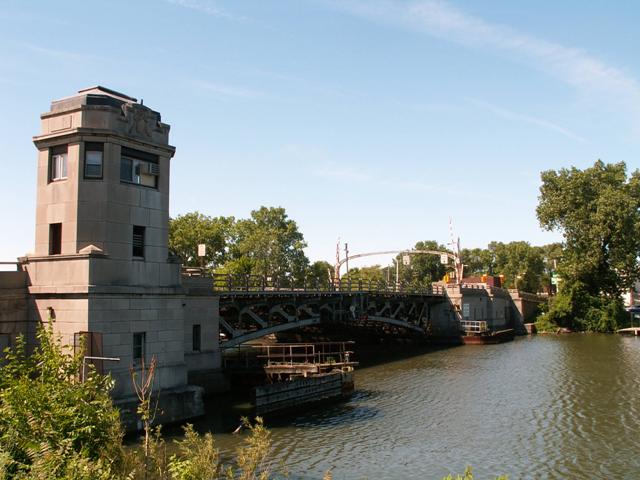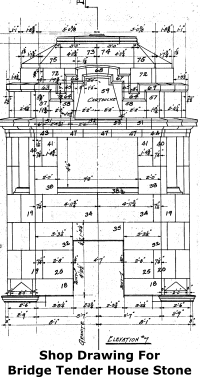We Recommend:
Bach Steel - Experts at historic truss bridge restoration.
BridgeHunter.com Phase 1 is released to the public! - Visit Now
Fort Street Bridge

Primary Photographer(s): Nathan Holth and Rick McOmber
Bridge Documented: July 1, 2007
Detroit: Wayne County, Michigan: United States
Metal Rivet-Connected Pratt Deck Truss, Movable: Double Leaf Bascule (Fixed Trunnion) and Approach Spans: Metal Stringer (Multi-Beam), Fixed
1922 By Builder/Contractor: Bethlehem Steel Bridge Corporation of Steelton, Pennsylvania and Engineer/Design: Chicago Bascule Bridge Company of Chicago, Illinois
Not Available or Not Applicable
164.0 Feet (50 Meters)
281.8 Feet (85.9 Meters)
55.8 Feet (17.01 Meters)
1 Main Span(s) and 2 Approach Span(s)
82182071000B040

View Information About HSR Ratings
Bridge Documentation
This bridge no longer exists!
Bridge Status: Demolished and replaced in 2013.View Archived National Bridge Inventory Report - Has Additional Details and Evaluation
View the Environmental Assessment for the replacement of this bridge.
View The Original Plans For This Historic Bridge
This deck truss bascule bridge is similar to Dix Avenue Bridge. Alongside the Dix Avenue Bridge, the Fort Street Bridge is the last of its type in Detroit, and indeed all of Michigan. The only other highway truss bascule bridge in Michigan is the nearby Jefferson Avenue Bridge, which is a pony truss rather than a deck truss. The trusses of the Fort Street Bridge retain good integrity, as does the bridgetender structure. Original cable car towers remain in excellent condition on the bridge as well. Railings and deck are not original however. Despite these modifications, the Fort Street Bridge remains an important, historically significant transportation related resource. It is historically and technologically significant, and is one of the most important movable historic bridges in the entire state.
The Wisconsin Bridge and Iron Company of Milwaukee, Wisconsin was the superstructure contractor. Greiling Brothers Construction Company of Green Bay, Wisconsin was the substructure contractor. Kuehne Electrical Company was the electrical contractor. George P. Cullen Incorporated was the contractor for the bridgetender buildings. Shop drawings for the bridge indicate that Wolverine Engineering and Construction Company of Detroit Michigan were also involved with the construction of the houses and enclosure walls. The Acme Cut Stone Company of Detroit, Michigan was a subcontractor for the stone work. The bridge was designed by the Chicago Bascule Bridge Company. This company was a business run by Hugh E. Young, an engineer who worked for the City of Chicago, who found Chicago's designs for the city so successful that Young ran a business on the side to design them for other cities. All three historic bascule highway bridges in Detroit were designed by City of Chicago engineers. Like the bascule bridges built in Chicago in the 1920s, the three bascule bridges designed by Chicago engineers in Detroit have the same unusually high level of attention given to aesthetics. From the structural details of an internally located operating rack to an under-deck counterweight to the elaborate stone architecture of the abutments and bridge tender houses, this bridge presents, along with the other two Chicago-designed bascule bridges on the Rouge River a beautiful appearance that defies its dreary, industrial surroundings.
Beyond its technological significance, the bridge is also historically significant for association with a historic event, the 1932 Ford Hunger March. The marchers stood on this very bridge. Five people were killed during the event.
Despite the obvious historic significance of this attractive bridge, MDOT plans to demolish the bridge. MDOT cites issues with the bridge that make preservation difficult or impossible. They mention that this bridge's abutments are built on clay rather than bedrock, and the bridge is, in basic terms, slowing sliding into the river. They reportedly can not do anything to stop this movement because of utility lines below the abutments. However, it is unclear to HistoricBridges.org as to why these utility lines could not simply be bypassed by new utility lines.
Because they will be demolishing a historic bridge using some portion of federal funds, MDOT is required to follow Section 106 protections for historic bridges. Therefore, as required mitigation for the demolition of this historic bridge, MDOT reports that they will be saving the operators house, as well as the abutment that is part of it, as a memorial to this bridge. This is certainly better than nothing. However, it is important to note that it is really the superstructure... the trusses... that make this bridge important, and that those are going to be destroyed.
Any time an agency wants to demolish a historic bridge, which is quite frequently, they always have a list of excuses that they present in a fashion that makes it appear as though preservation is impossible. Perhaps this is done to discourage preservationists from trying. Either way, examples of preserved examples elsewhere call into question MDOT's assessment that preservation is impossible or not feasible. In particular, Cook County, Illinois which includes Chicago, is a shining example. Within the county there are dozens of historic truss bascule bridges, many very similar to Fort Street, indeed designed by some of the very same engineers. Very few of these bridges have been replaced. Most have been well maintained and preserved. Some of these bridges are even designed to serve the same sort of freighter traffic as the River Rouge, particularly those on the Calumet River. Those who know the history of Chicago might know that the area Chicago is now was originally a mucky swamp that was filled in. Thus, it seems appropriate to assume that at least some of Chicago's bridges sit on unstable ground like the Fort Street Bridge, yet these bridges continue to act as key links to the third largest city in the United States. If Chicago can preserve dozens of bridges under these conditions, why can Detroit not save the three it has? Additionally, it should be noted that this bridge was designed by engineers who worked for the City of Chicago and had substantial responsibility in constructing many bridges in Chicago. These engineers were experienced with the soil conditions in Chicago, and knew what would work and what would not work. Therefore, it is difficult to find fault with the original bridge design, therefore it must be something in the way of maintenance (or lack thereof) that led to this bridge's current condition. Another oddity is the design of the replacement bridge, which is a Scherzer type rolling lift bascule. The design of the proposed bridge shows surprisingly little change in appearance and design from the bridges of this type that were designed and built by William and Albert Scherzer of Chicago. So it would appear that once again, Detroit is relying on a Chicago invention to bridge the River Rouge. However is a rolling lift bascule really the best choice for this crossing? The City of Chicago quickly dismissed rolling lift bridges. In the city's unstable swamp-based soil, rolling lift bridges wore out their abutments extremely quickly, because a rolling lift bridge in operation has a moving center of gravity, which puts considerable stress on all but the most stable abutments. Where abutments are stable, the design is reliable and many historic bridges of this type remain elsewhere. Chicago however had to rely on the unmoving center of gravity that a fixed trunnion bascule bridge like the historic Fort Street Bridge provides. If an unstable abutment was the problem with this historic bridge at Fort Street, why is it being replaced with a bascule bridge that requires nothing but the most stable conditions?
Information and Findings From Michigan Historic Bridge Inventory
Narrative Description This bridge is the oldest of a set of a dozen bascule bridges erected on the Rouge River in the 1920s to allow shipping to use the river for access to the Ford Motor Company River Rouge manufacturing complex. The Chicago Bascule Bridge Company was the builder. |
![]()
Photo Galleries and Videos: Fort Street Bridge
Bridge Photo-Documentation
A collection of overview and detail photos. This photo gallery contains a combination of Original Size photos and Mobile Optimized photos in a touch-friendly popup viewer.Alternatively, Browse Without Using Viewer
![]()
Maps and Links: Fort Street Bridge
This historic bridge has been demolished. This map is shown for reference purposes only.
Coordinates (Latitude, Longitude):
Search For Additional Bridge Listings:
Bridgehunter.com: View listed bridges within 0.5 miles (0.8 kilometers) of this bridge.
Bridgehunter.com: View listed bridges within 10 miles (16 kilometers) of this bridge.
Additional Maps:
Google Streetview (If Available)
GeoHack (Additional Links and Coordinates)
Apple Maps (Via DuckDuckGo Search)
Apple Maps (Apple devices only)
Android: Open Location In Your Map or GPS App
Flickr Gallery (Find Nearby Photos)
Wikimedia Commons (Find Nearby Photos)
Directions Via Sygic For Android
Directions Via Sygic For iOS and Android Dolphin Browser
USGS National Map (United States Only)
Historical USGS Topo Maps (United States Only)
Historic Aerials (United States Only)
CalTopo Maps (United States Only)






_Rouge_River.jpg)
